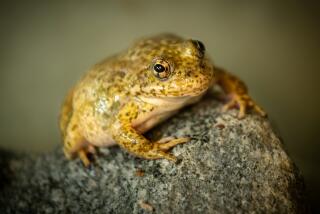Link Found Between Frogs’ Extinction, Global Warming
- Share via
MELVILLE, N.Y. — From Costa Rica to Peru, a fungal epidemic fueled by global warming may have wiped out dozens of frog species in otherwise pristine environments, a new study concludes.
Within the last 20 years, about two-thirds of Central and South America’s 110 brightly colored harlequin frog species have vanished. A killer fungus with a worldwide range and an affinity for amphibian skin previously had been indicted as a prime suspect in their disappearances. But a study published today in the journal Nature concludes that the fungal epidemic has been stoked primarily by global warming, a finding that may have broad implications for at-risk species around the world.
“The basic message is that global warming is already causing species extinctions, and a lot of them,” co-author J. Alan Pounds said when reached by phone at the Monteverde Cloud Forest Preserve and Tropical Science Center in Costa Rica, where he is resident scientist. In this case, he said, lethal disease may be the bullet, but climate change is “pulling the trigger.”
A hypothesis blaming the fungus and climate change had been a conundrum for researchers, because the fungus is known to prefer relatively cool temperatures, between about 63 and 77 degrees. Perhaps, as some suggested, global warming may benefit frogs by keeping their habitats too hot for the fungus to thrive.
“But paradoxically, the losses of harlequin frogs were taking place in unusually warm years,” Pounds says.
He and his collaborators discovered a solution to that conundrum in detailed records of the region’s weather trends: Although night temperatures in the hard-hit mountain habitats went up, daytime temperatures actually went down, perhaps caused by global warming’s ability to increase cloud cover in mountainous areas.
Before the upward creep of global temperatures in the 1970s, Pounds said, the amphibian fungus was held in check by normal fluctuations that made the daytime too hot or the nighttime too cold. Many harlequin frog habitats -- especially in the middle elevations where most extinctions have occurred -- have been moderated by global warming, enough to create just the right temperature for lethal fungus.
Researchers have long maintained that amphibian declines may be warning of greater perils. And scientists have indicated that global climate changes could pose big threats to such cold-weather species as polar bears, reindeer and penguins.
Andrew Blaustein, a herpetologist at Oregon State University, said Pounds’ study went beyond making predictions by showing “that global climate change is making an unequivocal impact on a wide range of animals.”
“What we have here is real animals going extinct with real climate change documented.”






